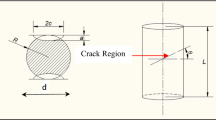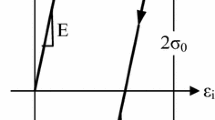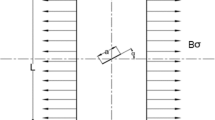Abstract
A rectangular plate with inclined cracks of different crack lengths at different crack inclination angles under biaxial loading condition are being analyzed in mixed mode condition using finite element method (FEM) for the determination of stress intensity factors (SIFs). With increases of the width of the plate and the crack length ratio, SIF increases up to 45° of crack inclination angle and then decreases; maximum value is obtained at 45° of crack inclination angle. With the increasing value of size factor, the value of SIF starts decreasing. The accuracy of the results of the proposed method is validated by comparing with the previously obtained results by theoretical and experimental methods. The FEM results give significant result for the two-dimensional mixed mode loading conditions.














Similar content being viewed by others
References
Sih, G.C., Paris, P.C., Erdogan, F.: Crack tip stress intensity factors for plane extension and plate bending problems. ASME J Appl. Mech. 29, 306–314 (1962)
Griffith, A.A.: The phenomena of rupture and flow in solids. Philos. Trans. R. Soc. Lond. A221, 163–197 (1920)
Westgaard, H.M.: Bearing pressures and crack. J. Appl. Math. Mech. 6, A49–A53 (1939)
Irwin, G.R.: Analysis of stress strains near the end of a crack traversing plate. Trans. ASME J. Appl. Mech. 24(3), 361–364 (1957)
Hafele, P.M., Lee, J.D.: Combination of finite element analysis and analytical crack tip solution for mixed mode fracture. Eng. Fract. Mech. 50(5–6), 849–868 (1995)
Mohanty, D.K., Maiti, S.K.: Experimental and finite element studies on mode I and mixed mode (I and II) stable crack growth-I, experimental. Eng. Fract. Mech. 37(6), 1237–1250 (1990)
Nhu, N.H., Giang, N.T.: Calculation of fracture mechanic parameter via FEM for some cracked plate under different loads. Vietnam J. Mech. 28(2), 83–93 (2006)
Singh, V.K., Gope, P.C.: Photoelastic determination of mixed mode stress intensity factor. J. Solid Mech. 3, 233–244 (2009)
Paris, P.C., Sih, G.C.: Stress analysis of cracks. In: Fracture Toughness and Testing and its Applications, vol. 381, American Society for Testing and Materials, Philadelphia, pp. 30–83 (1965)
Liebowitz, H., Lee, J.D., Eftis, J.: Biaxial load effects in fracture mechanics. Eng. Frac. Mech. 10, 315–335 (1978)
Author information
Authors and Affiliations
Corresponding author
Rights and permissions
About this article
Cite this article
Bhagat, R.K., Singh, V.K. Effect of Specimen Geometry on Stress Intensity Factors of Inclined Crack by Finite Element Method. J Fail. Anal. and Preven. 13, 463–469 (2013). https://doi.org/10.1007/s11668-013-9697-y
Received:
Revised:
Published:
Issue Date:
DOI: https://doi.org/10.1007/s11668-013-9697-y




